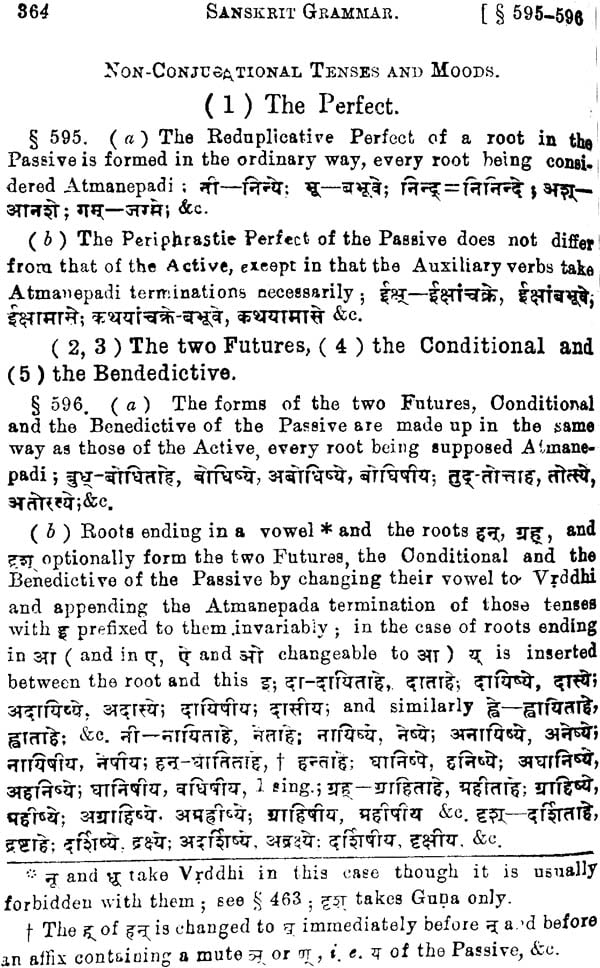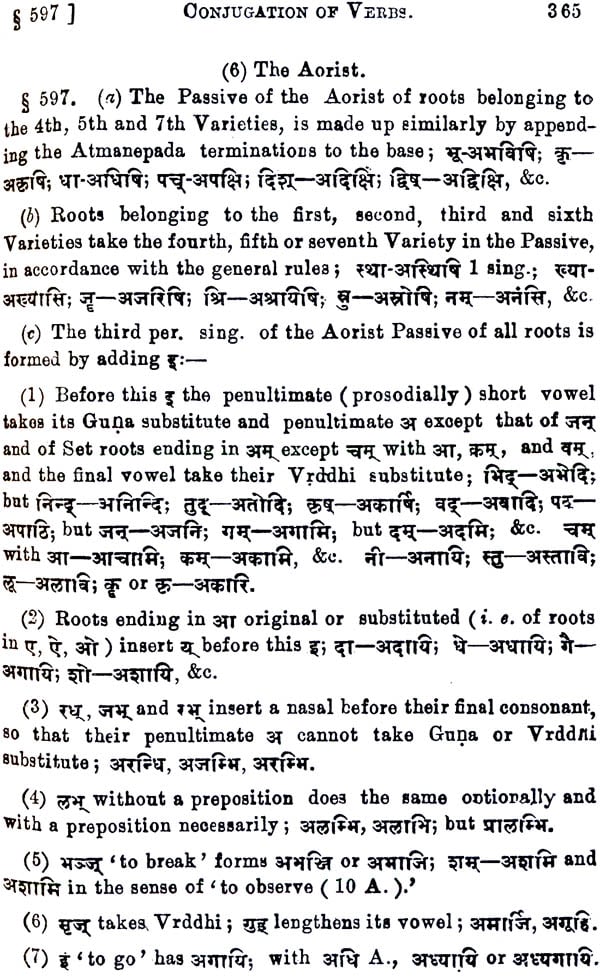
A Higher Sanskrit Grammar
Book Specification
| Item Code: | IDD544 |
| Author: | M.R. KALE |
| Publisher: | MOTILAL BANARSIDASS PUBLISHERS PVT. LTD. |
| Language: | English |
| Edition: | 2016 |
| ISBN: | 9788120801783 |
| Pages: | 731 |
| Cover: | Paperback |
| Other Details | 7" X 4.8" |
| Weight | 470 gm |
Book Description
The present grammar has been prepared with a view to meet the growing educational need of university students. The author has done his best to bring the present grammar up to the requirements of the students. In writing the various chapters of this book, the author has closely followed Panini, as explained by Bhattoji Diksita. Many of the rules given here are translations of the relevant Sutras of Panini. The original Sutras are given in footnotes, where necessary. Sandhis and declensions are fully treated; compounds which dominate classical Sanskrit literature have received special attention; formation of feminine bases has been illustrated; Taddhita affixes have been arranged in an alphabetical order. A special feature of the present grammar is the chapter on the "Conjugation of Verbs." The general rules given are amply illustrated by examples. All verbs which change their pada when preceded by particular prepositions are given in an alphabetical order. The chapter on Syntax contains almost everything given in the first 20 chapters of author's Guide to Sanskrit Composition: the chapter on Prosody is based on the Chandomanjari and the Vrttaratnakara. The author has spared no pains to make the book as useful and as complete as possible.
The present Grammar has been prepared with a view to meet the growing wants of the Indian University students. The University examiners have been, of late, evincing a desire to exact a more thorough knowledge of the obscurer and therefore more difficult parts of Sanskrit Grammar, than was required formerly. In fact, a student of the present day, with Sanskrit for his second language, must, if he wishes to pass his University examinations with credit, acquire more than a general knowledge of the various departments of Sanskrit Grammar; while none of the grammars now accessible to the Indian student with the exception of one or two, supply him with the necessary information on the various topics discussed in the original Sanskrit works. Dr. Bhandarkar’s books, though ingeniously sketched and admirably executed, are admittedly meant to introduce a student to the vast field of Sanskrit Grammar. Dr. Kiolh0rn’ Grammar aims more at brevity and perspicuity than at fullness of treatment with conciseness. Prof. Whitney’s grammar is too elaborate, and therefore too high for the ordinary student. Prof. Monier Williams} grammar, and others, though excellent in themselves, are expressly written for European students and are more suited to them than to the Indian student. I have, therefore, done my best to bring the present Grammar up to the requirements of the high standard.
Now, a few words on the scope and arrangement of the work and I will conclude. As remarked by Dr. (Now Sir) Bhandarkar Grammar was not an empiric study with Panini and the other ancient grammarians of India." In fact in the hands of the ancient Grammarians of India, Sanskrit Grammar rose to the dignity of a science and must be studied as such. To quote the words of the learned Doctor again "its study possesses an educational value of the same kind as that of Euclid and not much inferior to it in degree. For to make up a particular form the mind of the student has to go through a. certain process of synthesis." To split up, therefore, a general rule of the ancient Indian grammarians into a number of the particular eases it comprehends, as is done by some modern writers on Sanskrit grammar, is not to build up but to destroy, not to simplify the difficulties of the student but to embarrass him. For a Grammar, then, to be practical and correct, in my humble opinion, it must be based on indigenous works understood and studied in their genuine scientific spirit. In writing the various chapters of this book (except the one on the ‘Conjugation of Verbs’) I have closely followed Panini as explained by Bhattoji Dikshit (the Kashika of Vamana being also occasionally referred to). Many of the rules given are translations of the Sutras of Panini, much matter being thus compressed into a small compass. The original Sutras, where necessary, are given in foot-notes as helps to memory.
Sandhis and declensions are very fully treated. Compounds which play such an in important part in Sanskrit literature, and which, yet, are very summarily disposed of in many grammars, have received special attention, almost everything in the Siddhanta. Kaumudi being included. The formation of feminine bases which is not considered separately in other grammars has been treated of here in a separate chapter (VI). The seventh chapter deals with the Taddhita affixes (i. e. affixes forming secondary nominal bases) which, for the convenience of the student and the occasional referer, have been arranged here in an alphabetical order, each followed by a number of the derivatives formed by it. The question of gender which so much perplexes the foreigner has been dealt with in the eighth chapter, while the ninth treats of "Indeclinable.” The- first nine chapters this form what may be called the first part of the book, in as much as they deal with all that relates to the noun (declinable and indeclinable). But a special feature of the present Grammar is the chapter on the Conjugation of Verbs.’ No part of Sanskrit Grammar is more difficult and perplexing and therefore more calculated to tire out the patience of the young student, than the ‘Conjugation of Verbs} It is, therefore, written with a special attention to the student’s difficulties. The general rules given are amply illustrated by examples; Almost all the roots which are likely to puzzle the student in conjugating them in a particular tense or mood have been fully conjugated.
In the eleventh chapter, all the verbs which change their Pada when preceded by particular prepositions are given in an alphabetical order with illustrations where necessary. Two more chapters, one on syntax and the other on prosody, have also been added. The cliapler on syntax contains almost everything given in the first 20 chapters of Prof`. Apte’s ‘Guide to Sanskrit Composition of the same original having been followed by both. The chapter on prosody is based on the Chhandomanjari and the Vrttaratnakara, The book closes with a long list of verbs (added at the suggestion of my publishers) containing almost all the roots in Sanskrit and giving the 3rd pressing in the important tenses and moods.
Thus it will be seen that 1 have spared no pains to make the book as useful and as complete as possible. Also such of the technical terms used in original Sanskrit Grammars as the student always meets with in Sanskrit commentaries, are given in their proper places with their explanations. r In writing this Grammar, I have occasionally used Monier `Williams’s, Dr. Kielhorn’s and Whitney’ grammars to all of whom I make ample acknowledgements. My special thanks are due to Dr. Bhandarkar whose two books of Sanskrit were my chief guide in writing out the chapter (on) the ‘Conjugation of Verbs,’ and to the late Prof. Apte to whose excellent ‘Guide to Sanskrt Composition] I am indebted for some of the illustrations given in the Thirteenth chapter. I have also to thank my friend Mr. Uddhavacharya Ainapure for his occasional help and for the pains he took in preparing for this Grammar the list of Verbs added at the end and carrying it through the press.
This being the first attempt of the Author to bring into one volume the various departments of Sanskrt Grammar as fully and as concisely as possible, the Author hopes that the public will take an indulgent view of the work, and pardon him for any of the inaccuracies, mistakes of typography, &c. that might have crept in notwithstanding his best care. It is a sufficient excuse for these to say that the whole volume was written and carried through the press in less than a year. Be- fore concluding I have also to thank Mr. Vinayaka Narayana, Proprieter of the firm of Messrs. Gopal Narayan & Co., my publishers of this Grammar, for the care with which he passed the sheets through the press.
Lasty I beg to say that I shall be very grateful for any corrections and suggestions that may be sent me by my indulgent readers and critics and will try to profit by them if the book reaches a second edition.
CHAP.
- The Alphabet
- Rules of Sandhi:-
- Svarasandhi;
- Halsandhi;
- Visargasandhi.
- Subanta or Declension of nouns, substantive and adjective
- Bases ending in vowels (section I)
- Bases ending in consonants (section II)
- Irregular bases
- Words of irregular declension
- Pronouns and their Declension
- Numerals and their Declension
- Degrees of Comparison
- Compounds
- Dwandwa or the copulative compounds
- Tatpurusha or the Determinative compounds
- Karmadharaya or the Appositional compounds
- Upapada compounds
- Bahuvrihi or Attributive compounds
- Avyayibhava or the Adverbial compounds
- General rules applicable to all compounds
- Other changes in connection with compounds
- Formation of Feminine Bases
- Secondary Nominal Bases derived by the addition of the Taddhita or Secondary affixes
- Gender
- Avyayas or Indeclinables:-
- Prepositions,
- Adverbs
- Particles.
- Conjucations.
- Interjections.
- Conjugation of Verbs
- Active Voice (Section I)
1. Roots with unchangeable Bases (1st, 4th, 6th and 10th classes)
2. Roots of the 1st, 4th, 6th and 10th classes which form their bases irregularly
3. Roots with changeable bases (2nd, 3rd, 5th, 7th, 8th and 9th classes)
2. General or,- Non Conjugational tenses and moods
- (the two futures and conditional) First Future.
- Second future and conditional
- Perfect
- Irregular bases
- Periphrastic Perfect
- Aorist
1st Variety
2nd Variety
3rd Variety
6th Variety
7th Variety
4th Variety
5th Variety - benedictive
- Passive
- Non-Conjugational tenses and moods
- Perfect
- Aorist
- Derivative Verbs (Section III)
- Causals
- Desideratives
- Frequentatives
- Nominal Verbs
- Active Voice (Section I)
- Parasmaipada and Atmanepada
- Verbal Derivatives or Primary Nominal Bases.
- Syntax:-
- Concord.
- Government
- Pronouns
- Participles.
- Tenses and Moods.
- Indeclinables
APPENDIX:- 1. Prosody
- Samavrittas
- Vishama Vrittas
APPENDIX 2
- Dhatukosha







